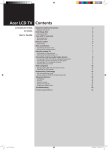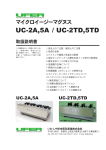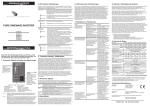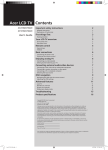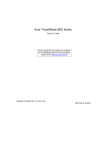Download Acer AT4220 Technical information
Transcript
Acer AT4220A/4220B/4220 LCD TV Service Guide Service guide files and updates are available on the ACER/CSD web. For more information, please refer to http:/ /csd.acer.com.tw PRINTED IN TAIWAN Revision History Please refer to the table below for the updates of LCD TV AT4220A service guide. Date II Chapter Updates Copyright Copyright© 2006 by Acer Incorporated. All rights reserved. No part of this publication may be reproduced, transmitted, transcribed, stored in a retrieval system, or translated into any language or computer language, in any form or by any means, electronic, mechanical, magnetic, optical, chemical, manual or otherwise, without the prior written permission of Acer Incorporated. III Disclaimer The information in this guide is subject to change without notice. Acer Incorporated makes no representations or warranties, either expressed or implied, with respect to the contents hereof and specifically disclaims any warranties of merchantability or fitness for any particular purpose. Any Acer Incorporated software described in this manual is sold or licensed “as is”. Should the programs prove defective following their purchase, the buyer (and not Acer Incorporated, its distributor, or its dealer) assumes the entire cost of all necessary servicing, repair, and any incidental or consequential damages resulting from any defect in the software. Acer is a registered trademark of Acer Incorporated. Other brand and product names are trademarks and/or registered trademarks of their respective holders. IV Conventions The following conventions are used in this manual. SCREEN MESSAGES Denotes actual messages that appear on screen. NOTE Gives bits and pieces of additional information related to the current topic. WARNING Alerts you to any damage that might result from doing or not doing specific actions. CAUTION Gives precautionary measures to avoid possible hardware or software problems. IMPORTANT Reminds you to do specific actions relevant to the accomplishment of procedures. V Preface Before using this information and the product it supports, please read the following general information. 1. This Service Guide provides you with all technical information relating to the BASIC CONFIGURATION decided for Acer's “global” product offering. To better fit local market requirements and enhance product competitiveness, your regional office MAY have decided to extend the functionality of a machine (e.g. add-on card, modem, or extra memory capability). These LOCALIZED FEATURES will NOT be covered in this generic service guide. In such cases, please contact your regional offices or the responsible personnel/channel to provide you with further technical details. 2. Please note WHEN ORDERING FRU PARTS, you should check the most up-to-date information available on your regional web or channel. For whatever reason, if a part number change is made, it will not be noted in the printed Service Guide. For ACER-AUTHORIZED SERVICE PROVIDERS, your Acer office may have a DIFFERENT part number code to those given in the FRU list of this printed Service Guide. You MUST use the list provided by your regional Acer office to order FRU parts for repair and service of customer machines. VI Chapter 1 System Specification Specification LCD Panel • Max. resolution: 1366 x 768 • Display color: 16.7 million colors • Life time: 60,000 hours • Input signal: one-channel LVDS • Contrast ratio: 1000/1 (Min) • Brightness: 4000 Cd/m2 (Min) • Response time: AUO typical gray to gray Tr=8ms (Max.) • Viewing angle: 89o (L)/89o (R), 89o (U)/89o (D) I/O Functions • RCA jack (YUV and CVBS) for YPbPr, YCbCr, video and audio • 15-pin D-sub for VGA • 24-pin DVI/HDCP for DVI-D (optional) • 19-pin HDMI connector (optional) • DIN45325 (IEC169-2) terminal for TV/CATV input • 3.5 mm earphone jack for audio line input Video Functions • PAL/NTSC/SECAM video format support • 480i/576i, 480p/576p, 1080i and 720p format support • Built-in dynamic adaptive smoothing filter • Built-in dynamic temporal frame-filter noise reduction • Built-in dynamic motion and edge adaptive de-interlacing • Screen display model 16:9 / 4:3 / panorama / zoom / PIP / POP Mechanical • VESA mounting holes Multi-Sound System • MTS (NTSC), FM-FM Power Source • Input voltage: 90~264V, 47~63Hz Chapter 1 1 • Power consumption: 291W • Stand-by: 5W Max. Remote Control • Multi-function remote control Speaker • Internal speaker: 10W x 2 • Amplifier: 10W x 2 stereo, adjustable volume Others • On-screen display adjustment function • ISP (In System Programming) function available for revising driver easily 2 Chapter 1 System Block and Wiring Diagram PANEL INVERTER I/O Board POWER Module MAIN Board A-Tuner AV 1 AV 2 Component1 Component2 SPEAKER Chapter 1 IR Receiver Key Board 3 LCD Main Board Block Diagram 4 Chapter 1 LCD TV Overview AT4220A/AT4220B/AT4220 Front Panel View 1 2 3 4 5 # Item Description 1 Power On/Off Powers on or off the LCD TV. 2 Menu key Turns the OSD menu on and off. 3 Channel up/down Channel up: When the OSD is on, functions the same as the Up arrow. Channel down: When the OSD is on, functions the same as the Down arrow. 4 Volume +/- Volume up: When the OSD is on, functions the same as the Right arrow. Volume down: When the OSD is on, functions the same as the Left arrow. 5 Input key When is OSD is on, press this button to confirm selection. Chapter 1 5 AT4220A Rear Panel View 1 2 # 6 3 Item 4 5 6 7 # 8 9 Item 1 Power switch 6 PC Audio-in 2 AC-in 7 AV-Audio L/R + COMPONENT 1/2 3 HDMI 8 AV-Audio L/R + CVBS 1/2 4 VGA-in 9 Analog antenna 5 DVI-D Chapter 1 AT4220B Rear Panel View 1 2 # 3 4 6 7 8 # Item 1 Power switch 6 Audio L/R + CVBS + COMPONENT 1/2 2 AC-in 7 Audio L/R + CVBS + COMPONENT 1/2 3 HDMI 8 Audio L/R + CVBS 1/2 + S-Video 4 VGA-in 9 Analog antenna 5 PC Audio-in Chapter 1 Item 5 9 7 AT4220 Rear Panel View 1 2 # 8 3 Item 4 5 6 # 7 8 Item 1 Power switch 5 PC Audio-in 2 AC-in 6 AV-Audio L/R + CVBS + COMPONENT 3 HDMI 7 SCART 4 VGA-in 8 Analog antenna Chapter 1 Remote Control AT4220A 1 2 3 4 5 6 8 7 9 10 12 14 11 13 16 15 17 18 # Item 19 21 20 Description 1 POWER Press to turn your TV on/off. 2 DISPLAY Press to display input/channel information (dependent on input/ source type). 3 MUTE Press to toggle audio on and off. 4 Input buttons (TV/AV/ COMPONENT/PC) Press to select correct input mode. 5 SLEEP Press to set a time period after which the TV will switch itself to standby (15, 30, 45, 60, 90 or 120 minutes). 6 Number keys Press to select the TV channel. Chapter 1 9 10 7 RECALL Press to return to the previous channel. 8 ENTER Press to confirm channel number selection. 9 MENU Press to open or close the Menu. 10 CC Press to select close caption and text service between CC1, CC2, CC3, CC4, Text1, Text2, Twxt3, Text4. 11 Directional keys/OK VOL (up/down) CH (up/down) N/A 12 WIDE Press to toggle scaling mode between 4:3, 16:9, Panorama and Letterbox 1, 2, 3 modes. 13 MTS Press to switch the sound system between stereo, main and SAP. Information is displayed on the top right-hand corner. 14 e (Empowering Technology) Press to activate Acer Empowering Technology. 15 VOL (+/-) Press to increase or decrease the volume. 16 CH (up/down) Press to sequentially select the TV channel. 17 PIP/PBP/POP Switch between PIP/PBP/POP modes. 18 SWAP For PIP/PBP mode: Toggle between the primary and sub-screens. 19 ACTIVE Toggle between primary and sub-screens. 20 POSITION When in PIP mode: Change sub-screen position. 21 SIZE/MODE When in PIP mode: Change sub-screen size. When in POP mode: Switch POP mode from 1+5 to 1+12. Chapter 1 AT4220B 1 2 3 4 5 6 8 7 9 10 12 14 11 13 16 15 17 18 # Item 19 20 21 Description 1 POWER Press to turn your TV on/off. 2 DISPLAY Press to display input/channel information (dependent on input/ source type). 3 MUTE Press to toggle audio on and off. 4 Input buttons (TV/AV/ COMPONENT/PC) Press to select correct input mode. 5 SLEEP Press to set a time period after which the TV will switch itself to standby (15, 30, 45, 60, 90 or 120 minutes). 6 Number keys Press to select the TV channel. 7 RECALL Press to return to the previous channel. 8 ENTER Press to confirm channel number selection. Chapter 1 11 9 MENU Press to open or close the Menu. 10 TTX/MIX (TELETEXT/ MIX) Press to return to the previous channel. 11 Directional keys/OK VOL (up/down) CH (up/down) N/A 12 WIDE Press to toggle scaling mode between 4:3, 16:9, Panorama and Letterbox 1, 2, 3 modes. 13 MPX Press to select the sound input, displayed in the top right-hand corner (mono, stereo, bilingual). 14 e (Empowering Technology) Press to activate Acer Empowering Technology. 15 VOL (+/-) Press to increase or decrease the volume. 16 CH (up/down) Press to sequentially select the TV channel. 17 PIP/PBP/POP Switch between PIP/PBP/POP modes. 18 SWAP For PIP/PBP mode: Toggle between the primary and sub-screens. 18 ACTIVE Toggle between primary and sub-screens. 20 POSITION When in PIP mode: Change sub-screen position. 21 SIZE/MODE When in PIP mode: Change sub-screen size. When in POP mode: Switch POP mode from 1+5 to 1+12. Teletext 1 2 7 3 # 12 Item 4 5 6 Description 1 Color buttons (R/G/Y/B) Operates corresponding button on the teletext page. 2 INDEX Press to go to the index page. 3 SIZE Press once to zoom teletext page to 2X. Press again to resume. 4 SUBTITLE Press to view subtitles on the screen. 5 SUBPAGE Press to access the teletext’s sub-pages directly. 6 HOLD Press to pause the current teletext page in multi-page viewing mode. 7 REVEAL Press to reveal hidden teletext information. Chapter 1 AT4220 1 2 3 4 5 6 8 7 9 10 12 11 15 14 # Item 13 Description 1 POWER Press to turn your TV on/off. 2 DISPLAY Press to display input/channel information (dependent on input/ source type). 3 MUTE Press to toggle audio on and off. 4 Input buttons (TV/AV/ SCART/PC) Press to select correct input mode. 5 SLEEP Press to set a time period after which the TV will switch itself to standby (15, 30, 45, 60, 90 or 120 minutes). 6 Number keys Press to select the TV channel. 7 RECALL Press to return to the previous channel. 8 ENTER Press to confirm channel number selection. 9 MENU Press to open or close the Menu. 10 TTX/MIX (TELETEXT/ MIX) Press to return to the previous channel. Chapter 1 13 11 Directional keys/OK VOL (up/down) CH (up/down) N/A 12 WIDE Press to toggle scaling mode between 4:3, 16:9, Panorama and Letterbox 1, 2, 3 modes. 13 MPX Press to select the sound input, displayed in the top right-hand corner (mono, stereo, bilingual). 14 VOL (+/-) Press to increase or decrease the volume. 15 CH (up/down) Press to sequentially select the TV channel. Teletext 1 2 7 3 # 14 Item 4 5 6 Description 1 Color buttons (R/G/Y/B) Operates corresponding button on the teletext page. 2 INDEX Press to go to the index page. 3 SIZE Press once to zoom teletext page to 2X. Press again to resume. 4 SUBTITLE Press to view subtitles on the screen. 5 SUBPAGE Press to access the teletext’s sub-pages directly. 6 HOLD Press to pause the current teletext page in multi-page viewing mode. 7 REVEAL Press to reveal hidden teletext information. Chapter 1 Basic Connection Connecting the Power Cord 1. Connect the AC cord into the AC input on the back of the set. 2. Connect the male plug to the wall outlet as shown. For AT4220A For AT4220B Chapter 1 15 For AT4220 Connecting an Antenna/Cable Connect the antenna cable to the appropriate antenna terminal on the back of the TV set as shown below. Getting Started Watching Your TV 1 2 4 1 3 1 1. Select the setup language you prefer. 16 Chapter 1 2. Please select country. 3. Ensure that your co-axial cables connected correctly before proceeding. 4. Scan for analog channels. 5. Setup is now complete. You are ready to begin watching TV. If you leave the setup process before it is complete, you will be given a choice of options: 1. Resume setup. 2. Resume setup wizard at next startup. 3. Exit and do not remind me. Select an option and press OK to exit. # Description 1 Power a. Turn on the power switch beneath the screen. b. Press the power button, number keys or channel up/down button on the remote control. good 2 Setup Wizard The first time you switch on the TV, the Setup Wizard will guide you to complete the language selection and channel scanning. Press OK key to begin the setup process. 3 Changing channels a. Press 0-9 on the remote control to select a channel. The channel changes after 2 seconds. Press ENTER to select the select the channel immediately. b. Pressing the channel (CH) up/ down button on the remote control will also change the channel. 4 Adjusting the volume Adjust the volume level using the (VOL) +/- button on the remote control. Chapter 1 17 Connecting External Audio/Video Device Connecting a DVD, VCR, STB or Audio/Video Equipment Connect your DVD player, VCR or audio/video equipment using the SCART port located at the rear of your LCD TV as shown below. For AT4220A Source-IN Y Yellow R Red W White Blue Green S S-video Note: Acer recommends the following priority for connection types: HDMI > D-sub > COMPONENT > S-Video > Composite. 18 Chapter 1 For AT4220B Chapter 1 Y Yellow R Red W White Blue Green 6 6YLGHR 19 For AT4220 Source-IN Y Yellow R Red W White Blue Green Note: Acer recommends the following priority for connection types: HDMI > COMPONENT > SCART > Composite. TV-OUT Note: SCART-out only works with analog broadcasts. 20 Chapter 1 Connecting a Camera, Camcorder or Video Game Connect your camera or camcorder to the video/audio ports on the rear of the TV set as shown below. Connecting a PC or Notebook Computer To display PC output on your TV, please connect your PC or notebook computer to the TV as shown below. For AT4220A Note: For VGA and DVI input, Acer recommends setting your PC’s external monitor resolution to 1360 x 768 at 60Hz. Chapter 1 21 For AT4220B For AT4220 22 Chapter 1 Selecting the Input Source Once you have connected your antenna or external equipment to the TV, you need to select the correct input source. Press the corresponding button on the remote control to select the correct input source. For AT4220A/AT4220B # TV AV 1 2 Item COMPONENT 3 PC 4 Input Button Guide 1 TV key Toggle Analog TV (ATV) between input sources. 2 AV key Toggle AV1, AV2, AV3-CVBS* and HDMI between input sources. 3 COMPONENT key Toggle COMPONENT 1, COMPONENT2 and AV3-COMPONENT* between input sources. 4 PC key Toggle VGA between input sources. For AT4220 1 # Item 2 3 4 Input Button Guide 1 TV key Toggle Analog TV (ATV) between input sources. 2 AV key Toggle AV1, AV2, AV3-CVBS* and HDMI between input sources. 3 COMPONENT key Toggle COMPONENT 1, COMPONENT2 and AV3-COMPONENT* between input sources. 4 PC key Toggle VGA between input sources. Chapter 1 23 OSD Navigation Many of the advanced settings and adjustments are available through using the OSD (on-screen display) menus, as shown in the example screenshot below. Basic operations required to navigate these menus (Picture, Audio, Channel management) Navigating the OSD with the Remote Control Note: You can also interact with these menus using the front panel controls. Please see “Front Panel View” section for details. No. Icon or Display Description There are six main OSD menus. These are: Picture, Audio, Channel management, Options, Settings and Empowering. Use the following method to navigate these menus. 1 Press the MENU button on the remote control or the MENU button on the control panel. 2 Select your desired menu by using the up and down directional keys to switch between the six menus. 3 Use the directional keys to interact with the menu. The up / down directions will scroll through the menu options, while left / right will adjust the different settings (for example, in the Picture menus, settings such as brightness, contrast, etc.) Press MENU to exit. Adjusting the OSD Settings The OSD can be used for adjusting the settings of your LCD TV. Press the MENU key to open the OSD. You can use the OSD to adjust the picture quality, audio settings, channel settings, options, 24 Chapter 1 general settings, and Empowering Technology. For advanced settings, please refer to following page. Adjusting the Picture Quality 1. Press the MENU key to bring up the OSD. 2. Using the directional keys, select Picture from the OSD. Then navigate to the picture element you wish to adjust. 3. Use the left or right keys to adjust the sliding scales. 4. The Picture menu can be used to adjust the current Scenario mode, brightness, contrast, color, sharpness and other image-related qualities. Adjusting the Audio Settings 1. Press the MENU key to bring up the OSD. 2. Using the directional keys, select Audio from the onscreen display. Then navigate to the feature you wish to adjust. 3. Use the left or right keys to adjust the sliding scale. Press OK to save. 4. The Audio menu can also be used to adjust the treble, balance, sound effects and other important soundrelated settings. Adjust the Channel Management 1. Press the MENU key to bring up the OSD. 2. Using the directional keys, select Channel management from the OSD. 3. Use the directional keys to navigate the menus. 4. The Channel management menu can be used to set channel skipped, select TV system and scan channels automatically. Adjusting other Options 1. Press the MENU key to bring up the OSD. 2. Using the directional keys, select Options from the OSD. 3. Use the directional keys to navigate the menus. 4. The Options menu can be used to select the picture aspect-ratio mode, set the sleep timer and other important options. Chapter 1 25 Adjusting the Settings 1. Press the MENU key to bring up the OSD. 2. Using the directional keys, select Settings from the OSD. Then navigate to the feature you wish to adjust. 3. The Settings menu can be used to adjust the menu language and other important settings. Note: The options available on the OSD may vary depending on the TV signal source. 26 Chapter 1 Empowering Technology Less than 2 seconds Default setting in different mode Set-up Empowering mode More than 2 seconds The Empowering Key brings up the Acer Empowering Technology functions. In TV mode, the choice is between Scenario mode and Favorite channel. Set-up Empowering Mode To change your Empowering Key’s default setting: 1 Press and hold the Empowering Key for more than two seconds to open the menu. 2 TV mode Empowering Key settings menu will come out. 3 Use the directional keys to navigate the menu and select the Empowering Technology icon. 4 Press MENU to exit. Now, when you press the Empowering Key, your chosen selection will be accessed. Default Setting in Different Empowering Mode Scenario mode in TV (Default Setting) Scenario mode has five preset viewing modes designed to give you the best picture quality when watching a particular kind of program. There are five pre-defined audio and video setting for Chapter 1 27 optimal enjoyment of the following scenario: Standard TV, Movie, Sport, Concert, Game, and User. Pressing the Empowering Key for less than two seconds will toggle between the different modes. Mode Information Standard Standard mode allows you to watch your favorite channels with sharp, brilliant imagery via adaptive brightness and contrast adjustments, and listen to clear-sounding audio. Movie For comfortably enjoying movies at home, Move mode displays dim scenes in clear detail; compensates for color; and smoothly presents motion images. This is accomplished through optimal Gamma correction plus saturation, brightness and contrast adjustments. Movie mode makes the most of high-definition movie sound tracks. Game Game mode carefully details the exquisite graphics of modern video games, providing lifelike entertainment while protecting your eyesight by adjusting brightness and contrast. What’s more, Game mode provides a heightened audio experience. Sports Sports mode us suited for outdoor sports program, with accurate background depth and clear gradation between the bright, outdoor playing field and darker auditoriums. Sports mode also brilliantly enhances colors and preset swiftly moving pictures without residual images. All of this is achieved via specific Gamma corrections and saturation adjustments. Precise audio can be heard. Concert Concert mode places you in a virtual concert hall, opera house or other dim environment by means of adaptive brightness and contrast adjustments. Concert mode accentuates symphonic harmonies and the tenor audio range. Favorite Channel Mode in TV Storing Favorite channels 28 1 Select your desired channel, then press the MENU key on the remote control. 2 Use the directional keys to navigate the menu and select the Empowering Technology icon. Chapter 1 3 Navigate to a channel slot, use CH up/ down button or number key to change channel. There are a total of five slots in which you can store TV programs. Viewing Your Favorite Channels On the remote control, if you press the Empowering Key for less than two seconds, the TV will toggle between the five stored TV channels sequentially according to your list of favorites. Chapter 1 29 Advanced Features PIP/PBP/POP • Press the PIP/PBP button once to display activate picture-in-picture (PIP). • Press twice to activate picture-by-picture (PBP). • Press three times to activate picture-on-picture (POP). Then, the POP screens will display the TV channel programs one by one. PIP POP POP POP PBP POP POP PIP (Picture-in-Picture) PBP (Picture-by-Picture) POP (Picture-on-Picture) Note: The OSD menu is not available in PIP/POP/PBP modes. PIP 1. Press the ACTIVE key to toggle between PIP screens. 2. Press the TV, AV, COMPONENT or PC keys, number keys or CH up or down to change the content of the active screen. TV AV COMPONENT PC 3. Press the SWAP key to change the content between the primary and the subscreen. PIP Swap PIP 4. Press the POSITION key to select the location of the subscreens, from upper left > upper right > lower right> lower left, as shown in the image. PIP PIP PIP PIP 5. Press the SIZE/MODE key to select the size of the subscreen, from 25% > 37.5% > 50%, as shown in the image. PIP 30 Chapter 1 PBP 1. Press the ACTIVE key to toggle between PIP screens. 2. Press the TV, AV, COMPONENT or PC keys, number keys or CH up or down to change the content of the active screen. TV AV COMPONENT PC 3. Press the SWAP key to change the content between the primary and the PBP screen. PBP Swap PBP POP 1. Press the ACTIVE key to toggle between POP screens. 2. Press the number keys or CH up or down to change TV channel on the active screen. 3. Press the SIZE/MODE key to access the 1+5 or 1+12 picture-on-picture mode as shown in the image. 1+5 POP POP 1+12 POP POP POP POP POP POP POP POP POP POP POP POP POP POP POP Note: In PIP and PBP, the VGA and DVI sources only support input up to 1360 x 768 pixels at 60Hz. For resolution higher than this, “Out of Range” will be displayed. The POP can only support 1+12 when the main screen source is HD content in VGA mode. Chapter 1 31 Lock TV Locking TV Content Lock TV is a handy feature that can block all TV sources. Lock TV allows you to enter a password and effectively stop anyone without the password from watching TV. If you want to set a personal PIN, please follow the steps below. 1. Press the MENU key on the remote control to bring up the OSD. 2. Use the directional keys to navigate to the Settings menu. Then select Set PIN. 3. Enter a four-digit password. Type it again and press OK to reconfirm. 4. Press MENU to exit. Note: The default PIN for this TV is “0000.” Enter “0000” when you want to change the PIN. If you forget your PIN, please enter 6163 to reset. If you want to lock your TV, please follow the steps below. 1. Press the MENU key on the remote control to bring up the OSD. 2. Use the directional keys to navigate to the Settings menu. Then select Lock TV. 3. Enter your PIN. Type it again and press OK to reconfirm. 32 Chapter 1 Hardware Specification and Configuration Electro/Optical Model AT4220A Panel specification Resolution (pixels) 1366 x 768 Brightness (tpe.) 500 nits Contrast ratio (tpe.) 1200/1 Display color 16.7 million Viewing angle H: 178 degrees V: 178 degrees Response (tpe.) 8 ms (gray to gray) Power supply Input 110V~240V 50~60Hz Max. power consumption 291W Power saving 5W Mechanical Dimensions (W x H x D mm) 1071 x 794 x 311 Weight (Kg) 32.3 Weight (lbs) 71.15 Wall mounting 400 mm x 200 mm Analog TV system TV color system NTSC Sound system M Stereo system BTSC/A2 Closed caption Yes V-chip US/Canada Analog TV-tuner quantity 1 Terminal Analog tuner in Yes AV1 CVBS, S-Video, Audio R/L AV2 CVBS, S-Video, Audio R/L COMPONENT1 YPbPr/YCbCr, Audio R/L COMPONENT2 YPbPr/YCbCr, Audio R/L HDMI Yes (HDCP) DVI Yes (HDCP) VGA Yes PC audio-in Yes Audio system Speaker Chapter 1 10W + 10W 33 Firmware Specifications Preset Mode for VGA Input 16 factory preset modes for VGA inputs are saved during the manufacturing process. Preset mode Pixel Format Hor. Freq. (kHz) Hor. Polarity Vert. Freq. (Hz) Vertical Polarity 1 720*400 31.47 70 + 2 640*480 31.47 60 3 640*480 37.861 72 4 640*480 37.50 75 5 640*480 43.4 85 6 800*600 35.156 56 + 7 800*600 37.879 + 60 + 8 800*600 48.077 + 72 + 9 800*600 46.875 + 75 + 10 800*600 53.7 + 85 + 11 1024*768 48.363 60 12 1024*768 56.476 70 13 1024*768 60.023 + 75 + 14 1366*768 47.7 + 60 + 15 832*624 49.7 75 16 1024*768 60.2 75 - Standard VGA VGA VESA VESA VESA VESA VESA VESA VESA VESA VESA VESA VESA VESA MAC MAC Power Saving While VGA is selected to input, this LCD TV is equipped with a power management according to VESA DPMS. There is a delay of 30 seconds before the transition from on-state to power saving state to avoid unintentionally entering of a power saving state during display resolution and timing mode changes. During the period of delay, the LED shall indicate green color and OSD will show “No VGA connection”. Transition from any power saving state to another can be instantaneous. The recovery from off-state requires no manual power on. Mode Power-On Stand-by Suspend Off-state Power off Hsync On Off On Off ͪ • Sync on: normal operation • Sync off: 34 Vsync On On Off Off ͪ Video Active Off Off Off ͪ Power < 180W < 5W < 5W < 5W < 5W Indication Green Red Red Red Dark Recovery time -<5s <5s <5s Turn on < 5s Chapter 1 • Hsync: f < 1KHz, duty cycle > 25% • Vsync: f < 10Hz, duty cycle > 25% The power consumption is valid over the specified voltage and frequency range. Power consumption is measured from AC source. There are no power saving modes for TV, AV1, AV2, COMPONENT 1 and 2, DVI and HDMI inputs. Performance Specifications The performance is checked at 25oC environment. White Balance and Uniformity Set contrast and brightness at maximum. • Standard: 10000 degree K (x=280, y=288) on x and y value. • Warm: 6500 degree K (x=312, y=329) on x and y value. • Cold: 14000 degree K (x=263, y=273) on x and y value. Display Area, Phase Center and Tilt • Display area: 42 inches diagonal • H-phase: A-B less than 1.5 mm • V-center: C-D less than 1.5mm • Tilt: E-F less than 1 mm E C A F B D Max. Brightness The brightness should exceed 350 Cd/m2 while set both of contrast and brightness to max. and color temperature of Standard is selected. (Typical value would be at 400 Cd/m2). Acoustical Noise With the display operation, the sound test is followed the ISO-7779 and shall be less than 35 dB/A in standard distance of 1 m. Also the display should not emit easily perceptible abnormal sounds. Power Supply Electrical Specifications Input Voltage and Frequency Range • Operating range of line voltage: AC 90V to 264V, 47Hz to 63Hz • Power consumption: under 291W Chapter 1 35 Line Fuse The AC input shall be fused and become electrically open as a result of an unsafe current condition. This fuse is inside the power supply converter and is not user replaceable, and must be returned for replacement. This fuse shall be well-selected to handle inrush current for all combinations of line voltage and frequency. Overall Dimension Unit: mm Environment Requirements Operating 25o +/- 5o for purity, white point, mis-convergence, luminance measurements and white uniformity measurement Operating temperature: Operating humidity: 0oC to 35oC 10% to 90% (non-condensing) Storage and Shipping Storage temperature: Shipping temperature: Storage humidity: Shipping temperature: -20oC to 60oC -20oC to 60oC 10% to 90% (non-condensing) 10% to 90% (non-condensing) Altitude Operating altitude: Shipping altitude: Storage altitude: 0 to 12,000 feet 0 to 40,000 feet 0 to 40,000 feet Units tested at an altitude up to 12,000 feet must operate at normal conditions without exhibiting abnormal behavior such as arcing or shutdown. 36 Chapter 1 Vibration Test The packaged display shall be capable of passing sinusoidal vibration test below. • Test conditions • A duration of 30 minutes in each orientation for the tested unit • Top and bottom side (z axis) • Left and right side (x axis) • Front and rear side (y axis) Drop Test The packaged display shall be capable of passing drop test as specified in following specification without any measurable degradation in performance or detectable mechanical or cosmetic damage. Filter: 330 Hz Dropping way: 1 corner, 3 edges, 6 flats Dropping height: see the table below Weight(kg) Chapter 1 L,R,Up side(cm) 0~9 Corner, edge, F,R,Btm(cm) 76 9~1 61 61 18~27 46 46 27~45 31 20 45~100 25 15 76 37 Multi Picture We only support video on graphic (VGA) multi-picture function. The configuration for multi picture is listed and described as the tables below. AV2 Component 2 VGA DVI X X X X X O X AV1 X X X X X X O X AV2 X X X X X X O X HDMI X X X X X X O X Component 1 X X X X X X O X Component 2 Component 1 AV1 X Sub HDMI TV TV Main X X X X X X O X VGA O O O O O O X O DVI X X X X X X O X O : support X: not support POP(1+5,1+12) Main & Sub Screen Combination AV2 Component 2 VGA DVI Component 1 AV1 X X X X X X O X X X X X X X X X Sub HDMI TV TV AV1 Main AV2 X X X X X X X X HDMI X X X X X X X X Component 1 X X X X X X X X Component 2 X X X X X X X X VGA X X X X X X X X DVI X X X X X X X X O : support X: not support 38 Chapter 1 Chapter 2 Machine Disassembly and Replacement General Information This chapter contains step-by-step procedures on how to disassemble the AT4220 series for maintenance and troubleshooting. To disassemble the TV, you need the following tools: • Wrist grounding strap and conductive mat for preventing electrostatic discharge • Small Philips screwdriver • Philips screwdriver • Hexagonal screwdriver • Tweezers Note: The screws for the different components vary in size. During the disassembly process, please group the screws with the corresponding components to avoid mismatch when doing assembly. When you remove the boards, please be careful not to scrape them. Warning!The module is drived by high voltage. If you need to handle the module during operation or just after powered off, you must take proper precautions against electric shock and must not touch the drive circuit portion and metallic part of module within 10 minutes. The capacitors in the drive circuit portion remain temporarily charged even after the unit is powered off. If the residual voltage is strong enough, it could result in electric shock. Thus, we strongly suggest that you put on the wrist ground strap and put the component on the conductive mat or bag. Besides, please keep the unit grounded during the whole process of disassembly and assembly. Before You Begin Before you proceed with the disassembly procedure, make sure that you do the following steps: 1. Turn off the power to the TV and all peripherals. 2. Unplug the AC adaptor and all power and signal cables from the TV. Chapter 2 39 Disassembly Procedures 1. Release the four screws securing the TV Stand. 2. Then remove the TV Stand as the arrows indicate. 3. Release the two screws holding the TV Stand cover. 4. Then remove the TV Stand cover. 5. Release the four screws fastening the right speaker. 6. Push the latch as the arrow indicates and disconnect the right speaker cable then remove the right speaker. 7. Repeat step 5 and step 6 to remove the left speaker. 40 Chapter 2 8. Release all the screws marked in red. Then lift the TV back cover as shown. Chapter 2 41 9. Release all screws securing the PCB holder. 10. Then remove the PCB holder as the arrows indicate. 42 Chapter 2 11. Release the four screws holding the I/O board. 12. Then detach the I/O board as the arrow indicates. 13. At first disconnect all the cables that connect to the main board. 14. Release the four screws fastening the main board then detach the main board. 15. Release the eight screws fastening the power board and the grounded wire. 16. Then remove the power board. Chapter 2 43 17. Release the two screws holding the IR board then detach the IR board. 18. Release the three screws holding the button board then detach the function board. 19. Detach function key. 20. Disconnect the LVDS cable and release the four screws holding the PCB tray. 21. Then remove the PCB tray with LVDS cable. 44 Chapter 2 22. Release the five screws securing the right inverter bracket and the inverter board. 23. Carefully disconnect the ten inverter backlight cables and the inverter board FFC. 24. Then detach the right inverter board. 25. Repeat these steps to detach the left inverter bracket and the left inverter board. 26. Release the screws marked in red then remove the right and the left LCD brackets. 27. Release the eight screws holding the LCD then you can remove the LCD. Chapter 2 45 Board Placement Please refer to this section to reconnect all cables when you do the assembly. 1. Speaker cable connector: The other ends of this cable link to the two speakers. 46 Chapter 2 2. LVDS cable connector: The other end of this cable links to the LVDS board. 3. Inverter cable connector: This is a three-end cable. The other two ends link the right inverter and the power board. We define this cable as Inverter R to Power Board to Main Board. Please refer to the photos below. Chapter 2 47 4. Main board to power board cable (eight pins and seven pins): The other end of this cable links to the power board. 5. Main board to power board cable (14 pins and 10 pins): The other end of this cable links to the power board too. 6. Main board to function board to IR board cable: The other two ends of this cable link to function board and IR board. 48 Chapter 2 7. Power board to left inverter board cable: The other end of this cable links to the left inverter board. Please refer to the photos below. Chapter 2 49 50 Chapter 2 Chapter 3 Troubleshooting Use the following procedure as a guide for Acer LCD TV AT4220 series problems. Note: The diagnostic tests are intended to test this model. Non-Acer products, prototype cards, or modified options could occur false errors and invalid system responses. 1. Duplicate symptom and obtain the failing symptoms in as much detail as possible. 2. Distinguish symptom. Verify the symptoms by attempting to re-create the failure by running the diagnostic test or by repeating the same operation. 3. Disassemble and assemble the unit without any power sources. 4. If any problem occurs, you can perform visual inspection before you follow this chapter’s instructions. You can check the following: • Power cords are properly connected and secured; • There are no obvious shorts or opens; • There are no obviously burned or heated components; • All components appear normal. 5. Use the following flow chart determine which part to be replaced. Chapter 3 50 Symptoms Can Not Power on A no Power code Plug in? Check Power code no LED Bright? Replace Power board or Main board Or IO board or All cable / LED Bright Green color ? no OK Check Remote control and keypad ? Replacement M/B NG Replacement Remote control or IR board or Keypad board LCD Panel can Display ? no Check panel’s all cable Replacement Cable no Check M/B Replacement Panel Replacement M/B END 51 Chapter 3 LCD No Backlight B Inverter power Cable had Plug in LCD Panel Backlight no no Change Inverter Power Cable Replacement Power/B Bright ? LCD Panel Backlight Bright ? no Replacement LCD Panel Inverter /B LCD Panel Backlight no Replacement Main/B Bight END Chapter 3 52 Remote Control No Function C Remote Control have battery? IR Board Cable plug in Press Remote Menu Key OSD can Display? Change Battery Check IR/B cable or Replacement IR/B Cable Replacement IR/B Press Remote Menu Key OSD can Display? Replacement M/B END 53 Chapter 3 Button Keys No Function D Key Board Cable plug in Press Menu Key check have Function? Check K/B cable or Replacement K/B Cable Replacement K/B Cable Press Menu Key check have Function? Replacement K/B Cable End End Chapter 3 54 RF No Display E RF Cable no plug in Check RF cable or Replacement RF Cable Replacement I/O board RF Can Display no Replacement M/B END 55 Chapter 3 COMPONENT1 and COMPONENT2 No Display F Component Cable plug in? Check Component cable or Replacement Component Cable Replacement I/O Board Component cat display Replacement M/B Board END Chapter 3 56 AV1 and AV2 No Display H CVBS Cable plug in? Check CVBS cable or Replacement CVBS Cable Replacement I/O Board CVBS cat display Replacement M/B Board END 57 Chapter 3 Speaker No Sound H Audio R/L source had plug IN? Video can Display ? no no Check Audio R/L source cable Check Video cable or Replacement Video Cable Mute turn off Volume set 50 Speaker R/L cable plug IN? Speaker have Sound no no Check Speaker cable or Replacement Speaker cable Replacement IO/B or Speaker Output Speaker have Sound Output ? no Replacement M/B END Chapter 3 58 VGA No Display P VGA Cable plug in? Check VGA cable or Replacement VGA Cable Read EDID DATA EDID Data Normal? Write EDID data VGA can display? Replacement M/B END 59 Chapter 3 DVI No Display Q DVI Cable plug in? Check DVI cable or Replacement DVI Cable Read EDID DATA EDID Data Normal? Write EDID data DVI can display? Replacement M/B END Chapter 3 60 HDMI No Display R HDMI Cable plug in? Check HDMI cable or Replacement HDMI Cable Read EDID DATA EDID Data Normal? Write EDID data HDMI can display? Replacement M/B END 61 Chapter 3 HDMI No Sound L HDMI Cable plug in ? no Check HDMI cable or Replacement HDMI CABLE Read EDID DATA EDID Data Normal ? no Write EDID data Sound output? no Replacement Main/B END Chapter 3 62 VGA/DVI No Sound M PC/DVI can Display ? no Check Video cable or PC or Replacement VGA/DVI cable Mute turn off Volume set to 50 Audio Line in Cable Plug IN? no Sound Normal ? no Check Line in cable or Replacement Line in Cable Replacement Main/B END 63 Chapter 3 COMPONENT No Sound Z Component Cable plug in? Check Component cable or Replacement Component Cable Mute turn-off Volume =30 Earphone remove Component Source can Display? Check Component cable or Replacement Component Cable Component Sound Normal? Replacement IO/B Component Sound Normal? L1 END Chapter 3 64 AV1/S-Video No Sound 1 AV1/S-Video/R-L Cable plug in? Check Video and R-L cable or Replacement Video or R-L Cable Mute turn-off Volume =30 Earphone remove AV1/S-Video Source can Display? Check Video and R-L cable or Replacement Video or R-L Cable AV1/S-Video Sound Normal? Replacement IO/B AV1/S-Video Sound Normal? L1 END 65 Chapter 3 Chapter 4 FRU (Field Replaceable Unit) List This section gives you the FRU (Field Replaceable Unit) list in global configurations of AT4220 series. Please refer to this chapter whenever ordering for parts to repair or for RMA (Return Merchandise Authorization). Please note that WHEN ORDERING FRU PARTS, you should check the most up-to-date information available on your regional web or channel. For whatever reasons a part number change is made, it will NOT be noted on the service guide. For Acer authorized service providers, your Acer office may have a different part number code from those given in the FRU list of this printed service guide. You MUST use the local FRU list provided by your regional Acer office to order FRU parts for repair and service of customer machines. Note: To scrap or to return the defective parts, you should follow the local government ordinance or regulations on how to dispose it properly, or follow the rules set by your regional Acer office on how to return it. Chapter 4 66 Parts Partname Description Acer Part No. REMOTE CONTROLLER - EU REMOTE CONTROL EURT54BEACQT1 25.M25V7.001 REMOTE CONTROLLER - USA REMOTE CONTROLLER (EURT54BCACQT1) 25.M28V7.001 REMOTE CONTROLLER - AUS REMOTE CONTROLLER (EURT54BAACQT1) 25.M38V7.001 POWER BOARD "PWR 291W,DPS-291AP A(90~264VAC)" 55.M34V7.001 IR BOARD JL7 IR/B ASSY(FOR HV7) 55.M25V7.003 FUNCTION BOARD JL7 KEYPAD/B ASSY 55.M25V7.002 IO/TURNER BOARD - PAL EU HH6 IO/B ASSY(EU) 55.M12V7.004 IO/TURNER BOARD - NTSC NA HH6N IO/B ASSY(US)(FOR HV2N) 55.M28V7.001 IO/TURNER BOARD - PAL AU HH6A IO/B ASSY(PAL-AUSTRALIA) 55.M12V7.005 MAIN BOARD - PAL EU FOR AU HV7 M/B ASSY(EU)(FOR HV4E) AU 55.M34V7.002 MAIN BOARD - NTSC NA FOR AU HH2 M/B ASSY(US)(FOR HV4N)AU 55.M36V7.001 MAIN BOARD - PAL AUS FOR AU HH2 M/B ASSY(AUS)(FOR HV4A)AU 55.M40V7.001 LVDS CABLE - PANEL TO MB FOR AU CABLE ASSY HX4E LVDS AUO(20P/30P REV1A) 50.M34V7.001 INVERTER CABLE - INVERTER L TO POWER "CABLE ASSY HX4E INV-PANEL AUO 12P/ 10P,2A" 50.M34V7.002 INVERTER CABLE - INVERTER R TO POWER TO MB "CABLE ASSY HX4E INV AU(14P/10P/4P,2A)" 50.M34V7.003 CABLE - MB TO POWER BOARD 10P/14P CABLE ASSY HH7 MB-POW LG(10P/14P 1A) 50.M24V7.005 CABLE - MB TO KEY TO IR "CABLE ASSY HV4 MB/IR/BTN(10/9/8,REV1A)" 50.M34V7.004 SPEAKER CABLE "CABLE ASSY HH2 SPEAKER 2P/3P,4P,1A " 50.M12V7.005 CABLE - AUDIO TO POWER BOARD 8P/7P CABLE ASSY HX4 AUDIO/POWER(8P/7P REV1A) 50.M34V7.005 GROUND CABLE "CABLE ASSY HV9 GND(1P/1P,2A)" 50.M34V7.006 CABLE - SCART TO SCART "CABLE ASSY SCART-SCART VA1(20P/ 20P,R3A)" 50.M03V7.019 POWER CODE - AUSTRALIA POWCORD(AUST)3P V54AB300012180Q1 1.8M 27.M12V7.001 Accessory Board Cable POWER CODE - US POWER CORD SP-305+IS-14SVT 3P 1.8M US 27.M03V7.004 POWER CORD EU 3 PIN POWER CORD SP-023+IS-14H05VV-F3P 1.8M EU 27.M03V7.002 POWER CORD UK 3 PIN POWER CORD SP-60+IS-14H05VV 3P 1.8M UKLF 27.M03V7.003 POWER CORD SWISS 3 PIN POWER CORD(SWISS) 3P 1.8M(BLACK) 27.M11V7.001 POWER CORD ITALY 3 PIN POWER CORD SP-028+IS-14H05VV 3P1.8M ITLF 27.M03V7.001 FRONT BEZEL ASSY HV4 LCD-BEZEL ASSY 60.M34V7.001 BACK COVER ASSY AH4T BACK COVER ASSY 60.M34V7.002 Case/Cover/Bracket Assembly 67 Chapter 4 STAND ASSY HV4 STAND ASSY 60.M34V7.003 STAND COVER "STAND COVER HX4(EAHX4004,REV3B)" 42.M34V7.001 STAND BRACKET "STAND BKT HX4(FAHX4008,REV3A)" 33.M34V7.001 LCD BRACKET - L "PANEL BKT AUO L HX4(FAHX4005,REV3C)" 33.M34V7.002 LCD BRACKET - R "PANEL BKT AUO R HX4(FAHX4004,REV3C)" 33.M34V7.003 MAIN PCB TRAY "CHASSIS HX4(FAHX4001,REV3B)" 33.M34V7.004 PCB HOLDER - PAL EU "SHIELDING (EU) HV4E(FAHV4002,REV3A)" 33.M34V7.005 PCB HOLDER - NTSC NA "SHIELDING (NA) HV4N(FAHV4001,REV3A)" 33.M36V7.001 PCB HOLDER - PAL AUS "SHIELDING AU HX4(FAHX4013,REV3C)" 33.M40V7.001 WIRE SADDLE CHA-4 "WIRE SADDLE CHA-4 VV3(EBVV3006,REV3A)" 42.M03V7.012 WIRE SADDLE MWS-7 "WIRE SADDLE MWS-7 VV3(EBVV3010,REV3A)" 42.M03V7.013 FUNCTION KEY "FUNCTION KEY HV7E(EBHV7001,REV3A)" 42.M25V7.001 "LCD(TFT)42"" T420XW01 VER0" 56.M34V7.001 SPEAKER ASSY L SPEAKER ASSY HX4E (FS-0000085AB) 23.M34V7.001 SPEAKER ASSY R SPEAKER ASSY HX4E (FS-0000085AA) 23.M34V7.002 POWER LABEL "LABEL (POWER) HV4(HCHV4001,REV3A)" 40.M34V7.001 I/O TURNER LABEL -PAL EU "LABEL I/O TUNER EU HV9(HCHV9003,REV3A)" 40.M25V7.002 I/O TURNER LABEL - NTSC US "LABEL I/O TUNER NA HV9(HCHV9004,REV3A)" 40.M28V7.002 I/O TURNER LABEL - PAL AUS "LABEL I/O TUNER AU HV9(HCHV9005,REV3A)" 40.M38V7.001 "CLAMP AUO-R/L HX4(FBHX4002,REV3A)" "CLAMP AUO-R/L HX4(FBHX4002,REV3A)" 47.M34V7.001 "CLAMP AUO-D HX4(FBHX4003,REV3A)" "CLAMP AUO-D HX4(FBHX4003,REV3A)" 47.M34V7.002 "EMI CONTACT PAD HX4(JXHX4001,3A)" "EMI CONTACT PAD HX4(JXHX4001,3A)" 47.M34V7.003 "EMI GASKET LVDS HX4(GBHX4002,3A)" "EMI GASKET LVDS HX4(GBHX4002,3A)" 47.M34V7.004 "EMI GASKET UP HX4(GBHX4003,3A)" "EMI GASKET UP HX4(GBHX4003,3A)" 47.M34V7.005 "EMI GASKET DOWN HX4(GBHX4004,3A)" "EMI GASKET DOWN HX4(GBHX4004,3A)" 47.M34V7.006 "EMI GASKET POWER HX4(GBHX4005,3A)" "EMI GASKET POWER HX4(GBHX4005,3A)" 47.M34V7.007 SCREW M4.0*6.0-B(NI) SCREW M4.0*6.0-B(NI) 86.M08V7.005 SCREW T4*12-B(BNI) SCREW T4*12-B(BNI) 86.M25V7.003 SCREW M3*6-B(BNI) SCREW M3*6-B(BNI) 86.M08V7.003 SCREW T3*12-P (BNI) SCREW T3*12-P (BNI) 86.M34V7.001 LCD LCD TFT 42.0 IN. AU T420XW01 VER0 Speaker Label Miscellaneous Screw Chapter 4 68 69 SCREW M4*6 P (NI) SCREW M4*6 P (NI) 86.M01V7.002 SCREW M4*22B(BNI+WASHER+SPRING) SCREW M4*22-B(BNI+WASHER+SPRING) 86.M34V7.002 SCREW T4*12-B(BNI) SCREW T4*12-B(BNI) 86.M25V7.003 "NUT IO EA1(MBEA1001,REV3D)" "NUT IO EA1(MBEA1001,REV3D)" 86.M25V7.001 SCREW T3*8-B(BNI) SCREW T3*8-B(BNI) 86.M08V7.007 SCREW M3*6-B(BNI) SCREW M3*6-B(BNI) 86.M08V7.003 SCREW F3.0*6-B(NI) SCREW F3.0*6-B(NI) 86.M25V7.002 Chapter 4 Exploded Diagram of AT4220 Series Please refer to the following table and exploded diagram. # Partname Description Acer Part No. Q’TY 1 FRONT BEZEL ASSY HV4 LCD-BEZEL ASSY 60.M34V7.001 1 2 LCD TFT 42.0 IN. AU T420XW01 VER0 "LCD(TFT)42"" T420XW01 VER0" 56.M34V7.001 1 3 "CLAMP AUO-R/L HX4(FBHX4002,REV3A)" "CLAMP AUO-R/L HX4(FBHX4002,REV3A)" 47.M34V7.001 4 4 PANEL BKT AUO L HX4 PANEL BKT AUO L HX4 N/A 1 5 PANEL BKT AUO R HX4 PANEL BKT AUO R HX4 N/A 1 6 MAIN PCB TRAY "CHASSIS HX4(FAHX4001,REV3B)" 33.M34V7.004 1 7 POWER BOARD "PWR 291W,DPS-291AP A(90~264VAC)" 55.M34V7.001 1 8 MAIN BOARD - NTSC NA FOR AU HH2 M/B ASSY(US)(FOR HV4N)AU 55.M36V7.001 1 9 IO/TURNER BOARD NTSC NA HH6N IO/B ASSY(US)(FOR HV2N) 55.M28V7.001 1 10 SCREW M3*6-B(BNI) SCREW M3*6-B(BNI) 86.M08V7.003 38 11 PCB HOLDER - NTSC NA "SHIELDING (NA) HV4N(FAHV4001,REV3A)" 33.M36V7.001 1 12 BACK COVER ASSY AH4T BACK COVER ASSY 60.M34V7.002 1 13 SCREW T4*12-B(BNI) SCREW T4*12-B(BNI) 86.M25V7.003 38 14 RATING LABEL HV4 RATING LABEL HV4 N/A 1 15 I/O TURNER LABEL -PAL EU "LABEL I/O TUNER EU HV9(HCHV9003,REV3A)" 40.M25V7.002 1 16 POWER LABEL "LABEL (POWER) HV4(HCHV4001,REV3A)" 40.M34V7.001 1 17 SCREW T3*8-B(BNI) SCREW T3*8-B(BNI) 86.M08V7.007 7 18 "NUT IO EA1(MBEA1001,REV3D)" "NUT IO EA1(MBEA1001,REV3D)" 86.M25V7.001 2 19 SCREW M4*22B(BNI+WASHER+SPRING) SCREW M4*22B(BNI+WASHER+SPRING) 86.M34V7.002 10 20 STAND BRACKET "STAND BKT HX4(FAHX4008,REV3A)" 33.M34V7.001 2 21 STAND COVER "STAND COVER HX4(EAHX4004,REV3B)" 42.M34V7.001 1 22 STAND ASSY HV4 STAND ASSY 60.M34V7.003 1 23 "CLAMP AUO-D HX4(FBHX4003,REV3A)" "CLAMP AUO-D HX4(FBHX4003,REV3A)" 47.M34V7.002 1 24 SCREW M4.0*6.0-B(NI) SCREW M4.0*6.0-B(NI) 86.M08V7.005 8 25 SPEAKER ASSY L SPEAKER ASSY HX4E (FS0000085AB) 23.M34V7.001 1 26 SPEAKER ASSY R SPEAKER ASSY HX4E (FS0000085AA) 23.M34V7.002 1 27 SCREW M3*6-B(BNI) SCREW M3*6-B(BNI) 86.M08V7.003 5 28 IR BOARD JL7 IR/B ASSY(FOR HV7) 55.M25V7.003 1 29 FUNCTION BOARD JL7 KEYPAD/B ASSY 55.M25V7.002 1 Chapter 4 70 71 30 FUNCTION KEY "FUNCTION KEY HV7E(EBHV7001,REV3A)" 42.M25V7.001 1 31 WIRE SADDLE CHA-4 "WIRE SADDLE CHA-4 VV3(EBVV3006,REV3A)" 42.M03V7.012 1 32 WIRE SADDLE MWS-7 "WIRE SADDLE MWS-7 VV3(EBVV3010,REV3A)" 42.M03V7.013 6 33 SCREW T3*12-P (BNI) SCREW T3*12-P (BNI) 86.M34V7.001 8 Chapter 4


















































































